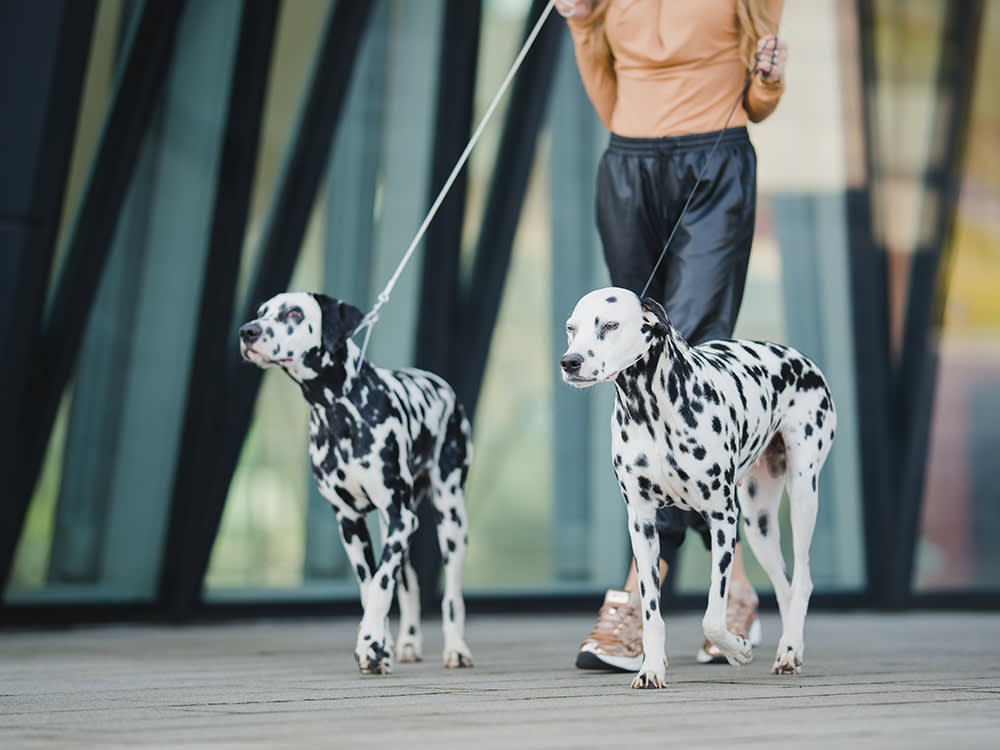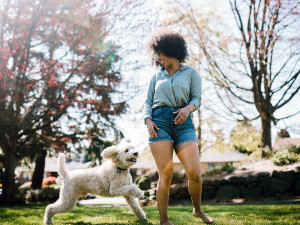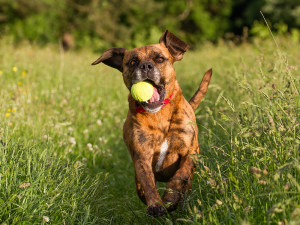How to Stop a Dog From Pulling on the Leash
Don’t worry: You’re not doomed to be pulled down the street forever.

Share Article
In this Article:
How to Stop a Dog From Pulling Reasons Dogs Pull on Their Leash Loose Leash Walking
If you have a pup who’s constantly pulling away from you on walks, you’re not alone. It’s a common behavioral problem — and it’s hard for many pet parents to watch their pups straining against a leash or collar. Not to mention, it can be dangerous for both dogs and people.
Luckily, there are a few tried-and-true ways to address leash pulling and help your pup calm down. Choosing the right harness, exercising your dog ahead of walks, going out during a calm time of day or in relaxed areas, adjusting your speed and direction — all these and more can make an enormous difference. Read on for how to help out a dog who just won’t stop pulling.
How to stop a dog from pulling on the leash
Teaching your dog to walk calmly on a leash without pulling will require lots of practice and patience, but it’s entirely possible. There are many options for anyone interested in how to stop a dog from pulling on leash, and the best success often comes from combining multiple methods.
How much do you spend on your pet per year?

It will take a concerted effort and a commitment to consistency to shift your dog’s gears, but it will be worth it when you’re able to stroll calmly together with a slack leash between you. You’re not doomed to be pulled down the street like you’re waterskiing forever, I promise!
1. Invest in power steering.
Changing the equipment you use to walk your dog can make a huge difference in your experience right away. The right kind of harness puts physics on your side so your dog can’t lean in with their full body weight to drag you along. The Freedom No-Pull Harness by 2 Hounds Design opens in new tab is one great option. Some people find bungee leashes helpful because the leash has a bit of give, but for strong, relentless pullers, I prefer a plain nylon, leather, or rope leash.
2. Use your own movement to your advantage.
If dogs are allowed to keep going forward, they learn that pulling is the way to get what they want, and they will keep doing it. Don’t ever allow your pulling dog to continue on their merry way. If your dog pulls, there are two options:
Stop immediately and don’t move until your pup lets up and there is slack in the leash. You may have to stop again five seconds later and do the same thing, and that’s OK. It’s important to be consistent about refusing to let them pull.
When they pull, turn and head in the other direction. That puts them behind you, at least momentarily, and your pup will not be pulling.
Both of these training methods require patience, but stay strong — it’s worth the wait! Whether the dog is pulling or not, be unpredictable, and reinforce the preferred behavior. Making quick turns, reversing direction, speeding up and slowing down all make you more interesting, which means it’s more likely that your dog will follow you, going where you’re going rather than pulling you where they want to go. True, some of your neighbors will find it amusing, but consider it just another good thing you’re doing for the community!
3. Exercise your dog before you walk.
I know, I know. You’re probably thinking, Isn’t the point of the walk to give my pup exercise? Yes and no. Exercise is only one of the benefits of a dog walk. Dogs on walks also get to be in a new environment that can be more engaging than being home, and they’re able to sniff and see other people and dogs.
For now, the goal of the walk is to teach them to walk nicely so they can go on future walks rather than to meet all their exercise needs right now. If your pup is tired when you start out, they’re less likely to pull. That helps them develop good habits and also allows you to reinforce their good behavior so it becomes more likely in the future. Playing fetch in the yard, or even going up and down the stairs multiple times, can take the edge off their energy.
4. Train your dog to have good leash manners.
While some dogs naturally walk politely and calmly all their lives with no training, that’s definitely not the norm. Most dogs need to learn how to do it with loose leash training. So, how to teach a dog to walk on a leash? Bring top-quality treats on every walk and give them to your pup whenever they are doing the right thing: walking without pulling you.
If you want them to walk next to you rather than in front, offer them treats when they’re in that position. The treats need to be out-of-this-world delicious — that usually means soft and smelly — to make an impact. Dry biscuits are not going to be up to snuff for most dogs.
5. Set your dog up for success.
Make it as easy as possible for your dog to do the right thing so you can reinforce them with those delicious treats. In addition to exercising your dog ahead of time (you can tell it’s important because I’m mentioning it twice!), there are other steps you can take to set your dog up for success.
Choose the time of day carefully and go when they tend to be the least excitable. Many dogs are extra energetic and jumpy mid-morning and in the late afternoon, but they may be a little calmer closer to the crack of dawn or later in the evening.
Another pro-tip: Walk them on an out-and-back route rather than a circular one. Many dogs pull on the way out but are more contained on the return because they’ve already investigated the route’s sights and smells.
6. Use a longer leash
There are dogs who pull when walked on a leash that is six-feet long who don’t pull when they are on an eight or 10-foot (or even longer) leash. They may still be six feet away from you or even closer, but they don’t pull.
Other dogs pull no matter how long the leash is — they just race out to the end of it and use the full force of their speed and body weight in an “I’m not into teamwork; thanks for asking” kind of way. You can’t know which category your dog is in until you try walking your dog on a longer leash, but longer leashes for dogs who pull can sometimes be a quick fix. If you don’t have a longer dog training leash, try securely attaching two leashes for an experimental walk, and only buy one if your dog’s behavior is better that way.
Why do dogs pull on the leash?
Pulling on leash happens for many reasons, and most dogs are engaging in this undesirable behavior for more than one of them. Generally speaking, dogs are pulling on leashes because that behavior results in them getting what they want, or they are trying to get what they want by pulling. Among the common reasons dogs pull are:
To reach something that interests them such as a toy,a person, a dog, an interesting smell in the grass, or a squirrel
They want to go faster than the current snail-like human pace
They are too energetic or too excited to control themselves
They lean into the pressure on the collar
Pulling has been reinforced in the past because they have previously gotten what they wanted by pulling
They are frustrated by being attached to you
They want to be a bit further from you or ahead of you
What is loose-leash walking, and does it help?
There is a tendency to think that either a dog is pulling on the leash and forcefully dragging their parent along or the dog is walking in a perfect heel position as if they are competing in formal obedience. There’s a beautiful middle ground that every dog parent should aim for, and that’s loose-leash walking.
That means your dog is walking with — wait for it! — a loose leash. That’s it, end of explanation. If you have a dog who walks on leash without pulling, there is slack in the leash, they wait for you, and they pay attention to the speed you are going to avoid creating tension on the leash, you have a dog who is successfully loose-leash walking. That also means you have a dog who is pleasant to walk and who very likely gets to go on more walks precisely because it is a pleasant experience for their parent.
I only teach dogs to heel if their people want me to for any reason, and I teach the dogs in my own home this skill only because people expect me from time to time, as a professional trainer, to have a dog heel. (Also, it’s appealing and pretty to me, like many other tricks are, but that’s highly secondary.) I don’t need a heeling dog, though. All I need is a dog who walks with a loose leash so that nobody feels tension on the leash or gets pulled around
FAQs
How do I know which method will work for my dog?
Most dogs do best with a combo of treats for not pulling and for being in the right position, plus frequent turns in response to pulling. The way to know what’s most effective for your dog is to try both methods.
What equipment do you need to leash-train a dog?
The best equipment for leash training dogs is either a harness that helps prevent pulling or a flat collar, a leash, and a lot of high-quality treats. That’s it!
What if my dog lunges or barks during walks?
Lunging and barking on walks may involve pulling, but there is no quick answer for improving this behavior. For now, turn away from what’s triggering this reaction. For long term improvement, consult with a professional behaviorist or trainer.
References

Karen B. London, PhD, CAAB, CPDT-KA
Karen B. London is a certified applied animal behaviorist (CAAB) and certified professional dog trainer (CPDT) who specializes in working with dogs with serious behavioral issues, including aggression. She has written for a variety of magazines including The Bark, Clean Run, and the APDT Chronicle of the Dog, and has published in scientific journals including Behavioral Ecology and Sociobiology, Ethology, Ecology, and Evolution, the Journal of Insect Behavior, and Insectes Sociaux. She is the author of seven books about dog training and canine behavior, including the forthcoming My Dog's Mystery Adventure: And Other Stories From a Canine Behaviorist and Dog Trainer.
Related articles
How to Manage Leash Reactivity in Your Dog
If your pup acts diabolical on walks, you are not alone. Here’s what you can do.
![Woman walking her dog in a park]()
Dog Walking 101: How Often Should You Walk Your Dog?
And why you shouldn’t skip the longer routes.
![Avoid heat stroke in dogs by sprinkling in the backyard with your dog]()
How to Keep Your Dog Safe From Heatstroke This Summer
Temperatures are rising dangerously. Keep your pet safe with these tips.
![A woman with curly black hair playing with her white labradoodle dog outside]()
7 Games That Can Actually Teach Your Dog Something
Cue the Schoolhouse Rock! because learning can be fun.
![Dog playing fetch with tennis ball in long grass]()
How to Teach a Dog to Fetch
For some dogs, it’s not as simple as just throwing a ball.





